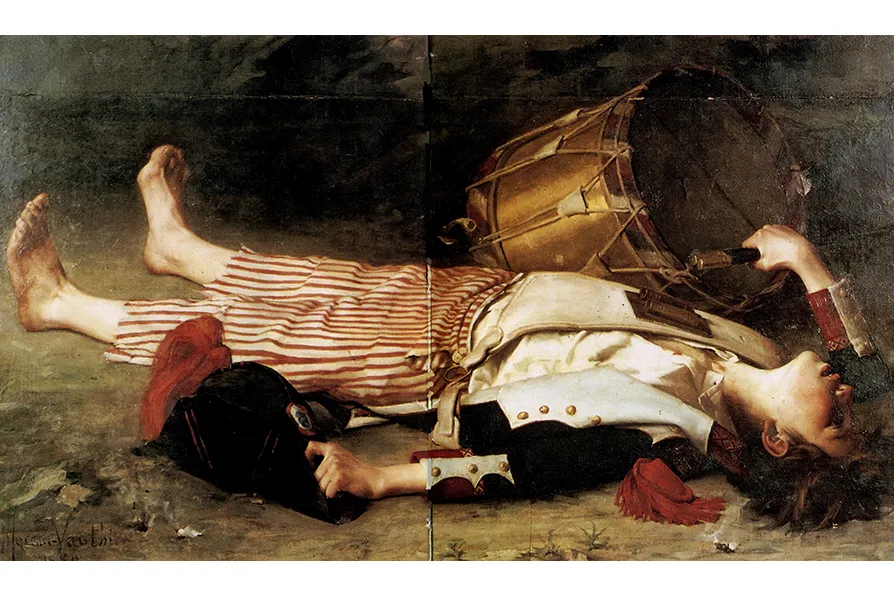Trump’s escalation against Venezuela is about more than oil, it is about regaining control over the ‘natural’ zone of influence of the United States at a moment where its hegemony is slipping, argues VIJAY PRASHAD
Error message
An error occurred while searching, try again later.JOHN CALLOW tells of the rise, fall and rise again of a young martyr to the early French republic, Joseph Bara, whose short life was elevated by Robespierre and, later, others for its emotional and ideological appeal

 The Death of Bara (19th century) by Charles Moreau-Vauthier. Credit: Public domain
The Death of Bara (19th century) by Charles Moreau-Vauthier. Credit: Public domain
THE mob growled out: “Cry ‘God Save the King’ and we’ll let you live’.” Cornered and already bloodied, the boy gave a defiant shout of “Long live the Republic!” and fell under a flurry of their blows.
Here is the essence of Joseph Bara’s story and posthumous fame. As the child hero of the French Revolution, he became the epitome of a new, politically and socially conscious youth, the icon of the Jacobins and the revolutionary army, and the subject of popular dramas, songs, pageants and prints.
His was a life selflessly given for the revolution and for republican ideals, that exposed the bitter and brutal nature of the civil war in the west, and the moral and ideological gulf that separated an old monarchical order, characterised by deference, inequality, superstition and brutality; from the new republic, of limitless possibilities, equality, reason and virtue.
As such, he became the archetype of the idealistic — and idealised — youthful rebel that blazed a spectacular trail for the European left from that moment onwards until the fall of the Berlin Wall, finding its reflection in figures such as Pavlik Morozov and Zoya Kosmodemyanskaya, all the way down to Samantha Smith, the US peace campaigner, in the 1980s.
Yet, as with all legends, the truth was far more complicated. Bara’s image was built from scant biographical material.
Indeed, we possess just two documentary sources that bookend his all-too-short life. The first is his baptismal certificate, issued a day after his birth, and the second is the report of his death in a relatively unimportant skirmish, written by his commanding officer just hours after the event.
From these, we learn that he was the ninth of 10 children, born at Palaiseau (near Versailles) on July 30 1779, the son of a gamekeeper in the employ of the notoriously reactionary Prince de Conde. His mother was widowed in 1784, and, as a consequence, the family fell into dire poverty.
After the revolution, military service appears to have offered the boy the opportunity of escape, adventure, advancement, and the ability to provide for his family. Indeed, his officer specifically noted that, throughout his service, Bara had limited “himself as to his food and clothing” and “passed onto his mother everything he could procure.”
Described as being “very young,” he was mounted and equipped as a hussar, and left home to serve as a volunteer in the campaign against the growing counter-revolution in the Vendee region of western France. He saw action in clashes with the royalist guerilla bands, was reported as being “unafraid to face all dangers” and, on at least one occasion, charged the Vendeans at the head of his troop, “taking down two brigands who had dared to attack him.”
At the end of November 1793, his unit was ordered to occupy Jallais, a village deep within insurgent territory and just 20km north of the Vendean stronghold of Cholet. There, on December 7, they were surprised by the Vendeans and, in the course of a brief, if bloody struggle, Bara was separated from his comrades, surrounded, and “preferred to perish rather than surrender and hand over the two horses he was driving.”
Shattered, his commanding officer penned a brief account of the defeat for the government, in which he emphasised Bara’s actions and asked for a modest pension to be granted to the boy’s mother in recognition of his undoubted heroism.
Matters might have ended there, with the petition being granted by a ministry clerk or the report simply being filed away in a drawer, had it not caught the attention of Maximilien Robespierre. With the republic torn by internal dissent and assailed by royalist revolts in the west and by the armies of Austria and Prussia along its eastern borders, it was badly in need of heroes who could valorise the struggle and make all of the hardships and losses seem worthwhile.
Bara fitted the bill perfectly. He appeared as a defender of liberty, handsome, altruistic, diligent and spirited; a youth with no political past who provided a potent link between a rising generation, and the refashioning of society being undertaken by the revolutionary government.
Consequently, Robespierre lost no time in retelling, and amplifying, his story at the session of the National Convention held on December 28 1793. To rapturous applause from both the delegates and the public galleries, Bara was celebrated for his “prodigious valour” and as the “model to arouse in young hearts the love of glory, of the homeland and of [republican] virtue.”
Significantly, in the course of his speech, Robespierre introduced for the first time the motif of the verbal exchange between the royalists and the young revolutionary, ending in the boy’s dying cry in support of the republic. It brought the convention to its feet, in standing ovation, sealed Bara’s fame, and marked the beginning of his cult. Yet, in anything other than mythopoeic terms, the words were never spoken. In fact, the subsequent testimony of his commanding officer suggested that the boy’s last utterances and refusal to surrender were couched in an understandable flurry of rage and expletives aimed at his killers.
The convention unanimously backed Robespierre’s call that the boy’s remains should be interred in the Pantheon — the new shrine to the nation’s revolutionary heroes, where Marat and Lepeletier had already been laid to rest — while Jacques-Louis David, the artist and Jacobin statesman, was commissioned to choreograph a grand secular festival to mark the occasion, complete with choirs, processions of mothers and children, drum bands, and a march past of military students, political activists drawn from the capital’s radical sections, and soldiers newly returned from the battle fronts.
A motion was passed to hang a print of Bara in every French schoolroom and youthful sans culottes requested their own festivals to commemorate the adolescent revolutionary, often linked to the unveiling of mass-produced plaster busts in his honour in former churches, town halls and radical political clubs. The “cult of Bara” rapidly spread to the provinces via the Jacobin Clubs, with Frejus, on the Cote d’Azur, being the first to host a civic fete, amid fireworks, banners and speeches, on January 19 1794.
The emotional and ideological appeal of this boy soldier and secular martyr to the republic appeared unstoppable and grew in the retelling. He was said to have been a child protege, to have opposed the landlordism of the Conde family, condemning their forestry laws, and to have saved his sister from the wolves while they were out gathering kindling in the woods. The poet, Andre Chernier, composed verses in his honour that were intended to educate and inspire, while his Chant du Depart name-checked Bara in a composition would become the de facto national anthem of the Napoleonic empire.
However, the rapidity of Bara’s rise to cultural prominence was followed by an equally dramatic fall.
The date set for his commemoration, July 28 (or Thermidor 10) 1794, was overtaken by events surrounding the fall of Robespierre the day before. Suddenly, Bara was a hero that no-one wanted, inextricably linked to Robespierre, the Jacobins, and the popular, ultra-democratic phase of the French Revolution. The festival in his honour was cancelled and his ashes, together with those of another boy soldier, the “little drummer,” Viala, were soon forgotten and lost.
David never finished his canvas of a dying, nymph-like Bara, clutching a revolutionary cockade to his heart, and retired to his bed in an attempt to avoid the “White Terror,” which engulfed the Jacobins. The “Gilded Youth,” a particularly vicious street gang of rich, young Parisians, broke-up the Pantheon and scattered the dust of Marat and Lepeletier, targeting women, and administering beatings to any sans culotte they could run to ground. Suddenly, youth was no gauge to progressivity, as visceral, reactionary class hatred reasserted itself on the streets of Paris.
Yet, Joseph Bara was far from finished and, in the wake of France’s humiliating defeat in the Franco-Prussian war, the Third French Republic redeployed his figure as a rallying call and model for emulation, for the nation’s youth.
As late as the 1960s, the Tintin journal was syndicating a comic strip celebrating Bara’s adventures. Today, the sense of promise unfulfilled remains as a potent force within the popular culture, registered by the hagiography of rockstars who departed long before their time, and within the left which lionises its “lost leaders,” of the stamp of Tom Maguire, Eleanor Marx, and Mary Macarthur, who (being safely dead) can never betray or sell out the movement.
However, at the root lies the simple, transformative reality of the French Revolution which signalled a profoundly optimistic rupture with the past. The people (individually and collectively) became conscious actors in their own lives; their stories, lives and labours held worthy of recording and celebrating, while humanity, itself, was perceived as being improvable and possibly, even, perfectible. Joseph Bara was a potent example of this shift and of the elevation of the poor, the talented and the politically conscious into both the historical record and the revolutionary narrative. For that, alone, he is deserving of fond remembrance.
John Callow is a GMB union officer writing in a personal capacity.










